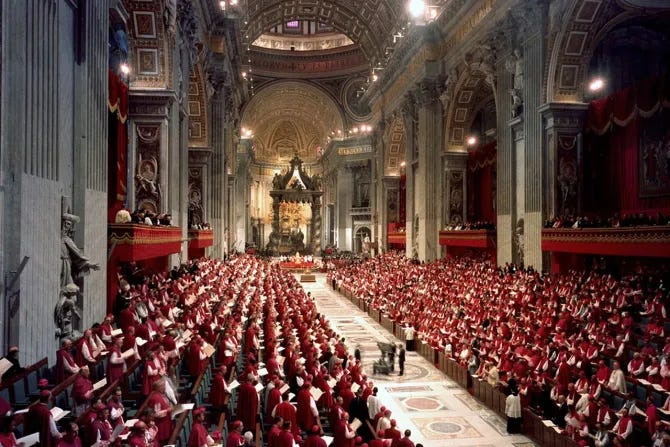In Defense of Inter Mirifica
Today (December 4th, 2013) marks the 50th anniversary of the first two documents to come out of Vatican II: Sacrosanctum Concilium (The Constitution on the Sacred Liturgy) and Inter Mirifica (The Decree on the Means of Social Communication). Of these two documents I can say two things with complete certainty:
Sacrosanctum Concilium is by far the more influential and groundbreaking of the two documents. Whenever I ask students if they can say something about how Catholicism now is different from how it was 50+ years ago, what they most usually come up with are liturgical changes: mass in the vernacular and the priest facing the congregation. Beyond this, the scholarly work available on Sacrosanctum Concilium is immense, erudite, and contentious, leading to a rich dialogue about its implications.
Inter Mirifica, on the other hand, is rarely read, and when it is, it’s generally dismissed, ignored, or even reviled. It is seen as offering nothing new in the Church’s teachings on the media; Theologian James Caccamo has described it as having a “backward looking” focus, while Norman Tanner has summarized the dissatisfaction with the document as “The view that Inter Mirifica represented a missed opportunity—to compose something better on an extremely important subject—has prevailed since the council.”
However, I think Inter Mirifica is more significant than its detractors claim. Now on its anniversary, it deserves both reconsideration and reevaluation.

First, Inter Mirifica represents the first Conciliar document to focus specifically on the media and the means of social communications. Since the close of Vatican I in 1870, the inventions of the telephone, radio, film, and television had radically altered the communications landscape in terms of speed and breadth of distribution. As access to these technologies became more widespread and affordable, the influence of producers of media content grew dramatically (a change reflected in the TV broadcast of Vatican II’s opening mass and the sheer number of journalists who covered the council). Dedicating an entire document to social communications highlighted the profound importance of the world of social communications – one of the great “signs of the times.”
Second, Inter Mirifica begins a shift in Catholic teaching on social communications. While in sections it emphasizes Catholic control of media (emphasized fairly consistently from Vigilanti Cura in 1936 through Miranda Prorsus in 1957), it also emphasizes the importance of formation in media. While this includes the basic level of technical competence (“Priests, religious and laity should…acquire the competence to use these media for the apostolate” – IM 15), more deeply it emphasizes the “formation of Christians” and the development of “a correct conscience on the use of the media” (IM 5). While at the time Inter Mirifica was mostly concerned with the right to information, the rights of art, and the formation of public opinion (IM 5-8), its insistence on the importance of context and circumstance in media provides the needed flexibility for considering issues that would arise later and have an impact on formation (IM 4). Indeed, an examination of the reception history of Inter Mirifica (what Ormond Rush has called “A Hermeneutics of the Receivers”), demonstrates the ongoing and underlying concern for the way social communications shapes and requires moral formation.
Third, Inter Mirifica avoids making major proclamations about social communications and instead calls for structures that will help the Catholic Church to think with the changing world of the media. It calls for “a pastoral instruction” on social communications, which was released in 1971 as Communio et Progressio. This document (which I recommend everyone read), provides a rigorous theological groundwork for understanding “communication” as “the giving of self in love” and for seeing the incarnation as the way in which God “communicated his very self” to humanity (CP 10). Inter Mirifica also called for an annual day which “on which the faithful will be reminded of their duties” (IM 18), which in 1967 became the first World Communications Day. Pope Paul VI described this day as an opportunity for the Church to make her own contribution to the orderly development of the world of social communications: a contribution of inspiration, encouragement, exhortation, guidance and cooperation.”
Lastly, Inter Mirifica called for “a special office of the Holy See” that would oversee the Church’s engagement with social communications” (IM 19). This became what is now called the Pontifical Council for Social Communications, which has continued to produce insightful and timely meditations, documents, and instructions on the media.
Ultimately, I think that Inter Mirifica’s brevity and limited scope are among its greatest assets. The types of media it was most concerned with were the press, the cinema, radio, and television. In 1963, there was no cable television, no internet (not even ARPANET), no mobile phones, no texting, no Facebook, no Twitter (i.e., no @Pontifex). Providing overly specific or definitive statements about the media in 1963 may have rendered the rest of the message obsolete. While it’s possible Inter Mirifica could have said more, I think it’s a gift that it did not say too much. Indeed, what it does say – the profound significance of social communications, the necessity of formation in light of the media, and the need for ongoing structures for thinking about social communications as the world grows and develops – are important enough on their own.
If you’re interested in more on Inter Mirifica, two sources I recommend are:
James Caccamo, “The Message on the Media: Seventy Years of Catholic Social Teaching on Social Communication,” in Josephinum Journal of Theology 15 no. 2 (Summer/Fall 2008): 290-426
Norman Tanner, The Church and the World: Gaudium et spes, Inter mirifica (New York: Paulist Press, 2005), 93-118



